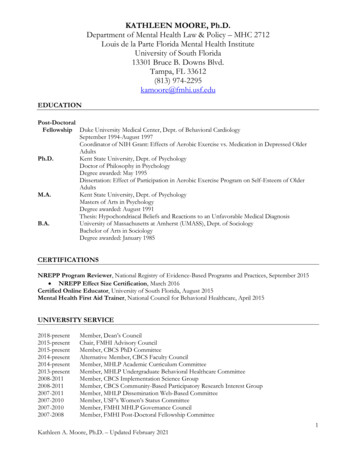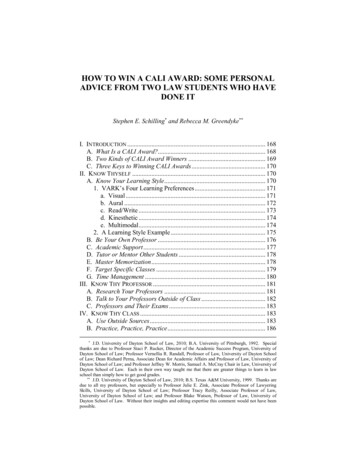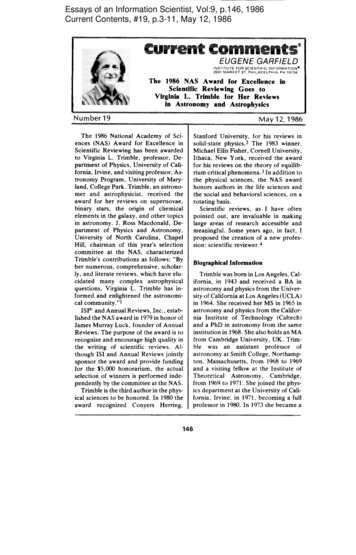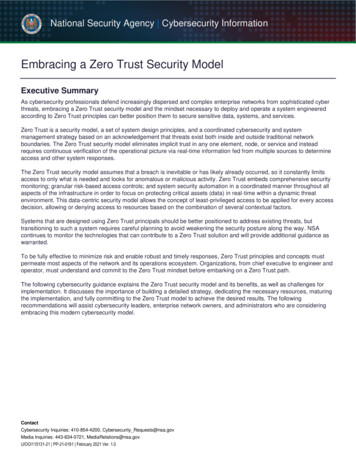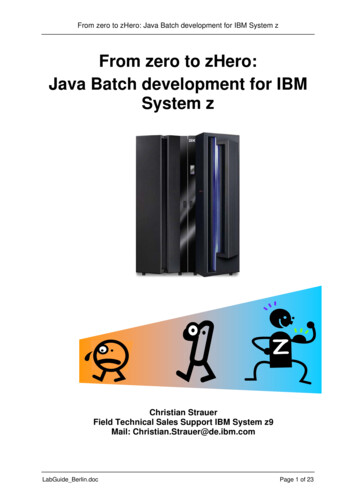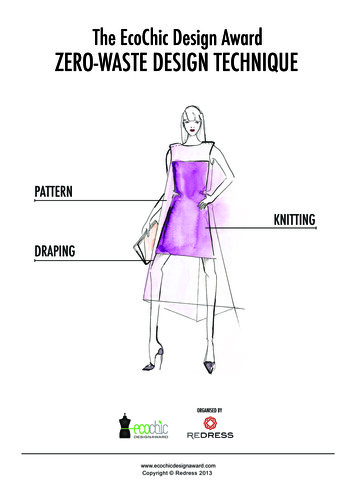
Transcription
The EcoChic Design AwardZERO-WASTE DESIGN TECHNIQUEPATTERNKNITTINGDRAPINGORGANISED BYwww.ecochicdesignaward.comCopyright Redress 2013
Model backstage at ‘Redress on the Runway’.WHAT IS IT?Zero-waste is a design technique that eliminates textile waste at the design stage.WHY DO IT?Approximately 15 percent of textiles intended for clothing ends up on the cutting room floor. 1When textiles are wasted so too are the resources, both natural and human labour resources,which were invested and imbedded into the textiles. It is vital to address the source of the problemby maximising the use of textile materials and by minimising the wastage. Adopting a zero-wastedesign approach reduces textile waste and the demand on natural resources.Timo Rissanen, ‘From 15% to 0: Investigating the creation of fashion without the creation of fabric waste’ Presenter,Kreativ Institut for Design og Teknologi, 20051www.ecochicdesignaward.comCopyright Redress 20131
HOW DO I DO IT?1FIRST DECIDEThere are various approaches to making a zero-waste garment. The one rule is that there shouldbe no wastage. So, first things first, decide what type of garment you wish to make and which zerowaste technique to use, for example draping, knitting or using a zero-waste pattern, as these willinform your design and sourcing options.EXPERT’S TIPSFerrando Chan, The EcoChic People’s Award 2011 Winner, created this cape bymaking a zero-waste pattern.www.ecochicdesignaward.comCopyright Redress 20132
Image credit Hellen Van ReesHellen Van Rees sourced leftover yarns from factories andthen wove the yarns in the shape of the garment. She fusedeverything together into the shape of the garment so in thefinal garment, there were no seams, cut-offs or leftovers.Angus Tsui Yat Sing, The EcoChic People s Award Hong Kong2012 Winner, created this zero-waste garment by pleatingrectangular textile waste scraps.Image credit Angus Tsui Yat SingEXPERT’S TIP— Timo Rissanen, Assistant Professor of Fashion Design and Sustainability at Parsons The NewSchool for Design —When I first started with zero-waste design I worked in a way that I had always worked, whichwas to sketch things and then move onto the pattern-cutting phase. But I changed my approachto zero-waste design when I realised that by keeping an open mind regarding the final outcome,with the same goal of making beautiful garments, allowed me to explore and invent new outcomes.www.ecochicdesignaward.comCopyright Redress 20133
3THEN DESIGN & SOURCEThe zero-waste design technique is an integrated design process, where designing and sourcinggo hand in hand. This means that you need to know your textile dimensions to be able to designyour garment; and like-wise you need to know your design dimensions to source your textile.Knowing both this information is vital, as you do not want to limit your design by having to workwith set textile dimensions, as this can often lead to creating unnecessary embellishments andcompromise your design.Creating a zero-waste garment is about minimising wastage, so when you source, find the textilethat will work for your design. Using textile waste will improve your garment’s sustainabilitycredentials, but is not a necessity.If you construct a zero-waste pattern you will need to plan the usage of the entire piece of textileby arranging your pieces like a jigsaw puzzle. You can also work out the pattern by draping.Alternatively, you can design directly by draping your entire piece of textile on the body directly.Image credit Winsome LokAman Cheung, The EcoChic Design AwardHong Kong 2011 Finalist, created this zerowaste sheer skirt with leftover stock fabric.Winsome Lok worked with this jigsaw puzzle-likepattern to create her zero-waste outfit.www.ecochicdesignaward.comCopyright Redress 20134
EXPERT’S TIP— Timo Rissanen, Assistant Professor of Fashion Design and Sustainability at Parsons The NewSchool for Design —The textile width is always a crucial consideration in zero-waste design. You can’t design zerowaste without knowing exactly how wide the textile is. The textile width is the space within whichyou create zero-waste fashion design.Image credit Timo RissanenTimo Rissanen worked with the dimensions of the textile to create a zerowaste pattern.www.ecochicdesignaward.comCopyright Redress 20135
4FINALLY. MAKE!This is where your sketching and pattern will be tested. Whether you drape, knit or use a zerowaste pattern, the important thing is that the whole textile is used and that there is no wastage.EXPERT’S TIP— Johanna Ho, Fashion designer —Be experimental and don’t give up too easily. Try different shapes, styles and ways of doing zerowaste and eventually you will get there.Image credit Johanna HoJohanna Ho cut textile waste into thinstrips and then turned the textile stripsinto yarns. She then knitted these textilewaste yarns to create this sweater.www.ecochicdesignaward.comCopyright Redress 20136
ADA ZANDITONON ZERO-WASTE DESIGNFashion Designerwww.adazanditon.com“Zero-waste design changes the way we use textiles and produces effective environmental results.”I take a common sense approach to sustainability. The zero-waste design technique is good forthe environment, as it eliminates textile waste going to landfill, and it is economically smart bygiving you the most mileage from your dollars. Waste produced during garment production can beavoided by applying the zero-waste design technique, where designers carefully plan the designso that they utilise the entire textile.The concept of utilising the entire width of the textile is not a new phenomenon. It has long beenused in the making of Japanese kimonos and Indian saris because it makes sense not to wastevaluable textiles. However, it became less popular after the industrialisation of fashion and theemergence of mass-produced fast fashion.Today, there are many different approaches to zero-waste design, including draping, knitting andsmart pattern making. I use a variety of waste reducing techniques to create sculptural, elegantand desirable sustainable fashion garments. For example, I used zero-waste geometric cutting forthe origami-inspired Hera dress (see image). For this, I took two squares and cut a line throughthem, and then joined the lines together and finally used buttons to fix the points of the dressinto folds. This design also incorporates the amount of textile needed for seam allowance andhemming. I also have a zero-waste policy in my studio where all textile residues are kept andreused or donated to local recycling programs.Elsewhere in this field, I think the most influential designer is Mark Liu who fits the pieces of hisdesigns together like a jigsaw puzzle onto the textile. Looking beyond individual designers and intothe mass market, the commercialization of zero-waste would be a huge step towards sustainabilityfor the entire fashion industry.”MY TOP TIPS TO ZERO-WASTE DESIGN1. Think before you cut and be inventive andexperimental2. Construct a zero-waste pattern or drapethe textile3. Sew or heat-seal the textile together4. Knit and you will only ever use thenecessary amount of material5. Be inspired by origamiImage credit Ada ZanditonHera Dress, SS’12 Poseisuswww.ecochicdesignaward.comCopyright Redress 20137
LEARN MOREWATCH THIS.The EcoChic Design Award 2013 Zero-waste Design Tutorial:YouTube http://youtu.be/rikkAuaoUGsYouku http://v.youku.com/v show/id XNTQ3MzkwNDI0.htmlThe EcoChic Design Award 2012 Zero-waste Design Tutorial with Timo RissanenYoutube www.youtube.com/watch?v vJK y56ot3IYouku http://v.youku.com/v show/id XMzg3ODMxOTAw.htmlREAD THIS.Cradle To Cradle: Remaking The Way We Make Things by Michael BraungartDesign Is The Problem: The Future Of Design Must Be Sustainable by Nathan ShedroffEco-Chic: The Fashion Paradox by Sandy BlackEco Fashion by Sass Brown and Geoffrey B. SmallFashion & Sustainability: Design for Change by Kate Fletcher and Lynda GroseShaping Sustainable Fashion: Changing The Way We Make And Use Clothes by Alison Gwiltand Timo RissanenSustainable Fashion And Textiles: Design Journeys by Kate FletcherThe Sustainable Fashion Handbook by Sandy BlackThe Zero-Waste Lifestyle: Live Well by Throwing Away Less by Amy KorstBE INSPIRED BY.Ada Zanditon www.adazanditon.comDavid Telfer www.davidtelfer.co.ukHellen Van Rees www.hellenvanrees.comHolly McQuillan www.hollymcquillan.comIssey Miyake www.isseymiyake.comJulia Lumsden http://www.julialumsden.com/Julian Roberts www.julianand.comMark Liu www.stique.comTimo Rissanen www.timorissanen.comLEARN THE LANGUAGE.Closed loop design is when a product is designed to have another function after its use therebyeliminating all waste. In this way, a used product’s output becomes the input for a new product orfunction.Cradle to cradle refers to a closed loop design process, which is free of waste. When a productis no longer useful, it becomes material for another product.Life cycle is the resource extraction, manufacture, distribution, use, disposal and recycling of awww.ecochicdesignaward.comCopyright Redress 20138
product.Post-consumer waste is waste collected after the consumer has disposed of it.Pre-consumer waste is manufacturing waste that has not reach the consumer.Recycled is when a waste material or product has been reused and turned into a new usablematerial or product.Reduce, reuse, recycle are the so called 3R’s that classify waste management, according totheir order of importance. Reduce your consumption and usage, reuse items again and recyclematerials.Supply chain are the resources and steps involved in moving a product from raw material toconsumer.Sustainability is a lasting system, process, that meets the current needs while preserving for thefuture.Sustainable fashion is clothing that is produced with respect to the environment and socialimpacts throughout its lifespan.Sustainable textile is a textile that is produced with minimal environmental impact.Textile waste is a material that is deemed unusable for its original purpose by the owner.Zero-waste is a design technique that eliminates textile waste at the design stage.www.ecochicdesignaward.comCopyright Redress 20139
Zero-waste is a design technique that eliminates textile waste at the design stage. Approximately 15 percent of textiles intended for clothing ends up on the cutting room floor. 1 When textiles are wasted so too ar



